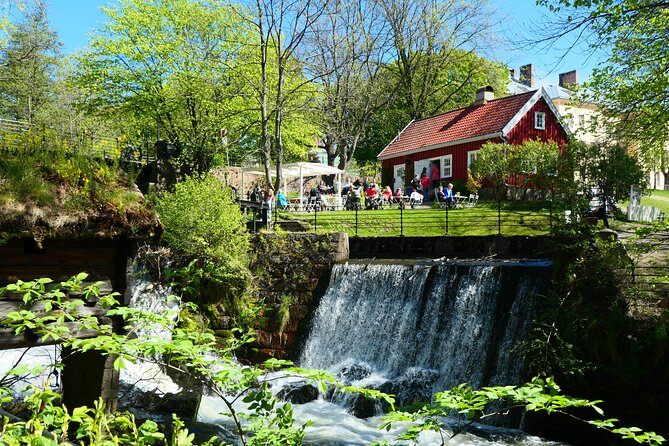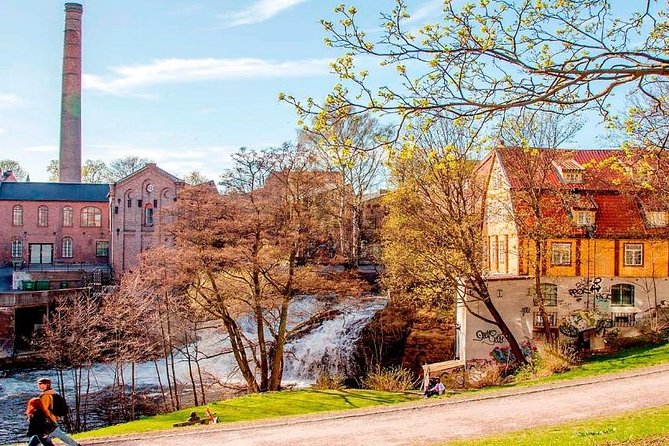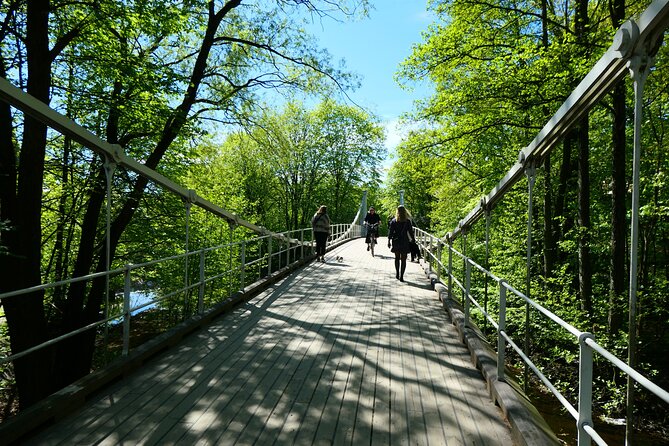Experience the enchanting blend of history and natural beauty with Oslo City Walks’ Historic River Walk.
Imagine strolling along the banks of the Akerselva River, where once bustling factories have given way to vibrant art galleries and cozy cafés.
This guided tour takes you on a fascinating journey through Oslo’s industrial past, offering a glimpse into the city’s transformation into a modern cultural hub.
But that’s not all – there’s a delicious surprise waiting for you at Mathallen, a gourmet food court that will tantalize your taste buds.
So, lace up your walking shoes and join us on this captivating exploration of Oslo’s historic riverfront.
This experience made our list of the 8 Best Historical Tours In Oslo.
Good To Know

- The Historic River Walk along the Akerselva River showcases Oslo’s rich industrial past and the transformation of former factories into vibrant art galleries and café spaces.
- The revitalization project has attracted travelers, created job opportunities, and added a new cultural dimension to the city.
- The transformation of the river has included the creation of parks, walking paths, and recreational spaces, as well as the restoration of native flora and fauna and the improvement of water quality.
- Former factories along the river have been turned into renowned music venues, art spaces, and gourmet food courts, preserving industrial heritage while embracing creativity and innovation.
Overview of the Historic River Walk
The Historic River Walk in Oslo offers visitors a captivating journey along the revitalized Akerselva River, where they can explore the city’s rich industrial past and witness the transformation of former factories into vibrant art galleries and café spaces.
This revitalization project has had a significant impact on the local economy, attracting travelers and creating job opportunities in the art and hospitality sectors. The conversion of the factories into galleries and cafes hasn’t only preserved the city’s heritage but also brought new life to the area, attracting both locals and travelers alike.
Plus, the revitalization of the Akerselva River has brought environmental benefits to the city. The river has been cleaned, creating a healthier ecosystem for plants and wildlife, and the surrounding parks and open spaces provide a green oasis in the heart of the city.
Interested in exploring Oslo on foot? Other walking tours we've covered
The Role of Akerselva River in Oslo’s Industrialization

Akerselva River played a pivotal role in propelling Oslo’s industrialization forward. Here are three key points highlighting the environmental impact and cultural significance of the river:
Industrialization: The river served as a vital source of power for Oslo’s early industries, driving the development of factories and mills along its banks. This led to the growth of various industries, including textile production, paper mills, and sawmills, which played a significant role in the city’s economic development.
Environmental Impact: However, industrialization also had a negative environmental impact on the river. The discharge of pollutants from factories led to water pollution and degradation of the river’s ecosystem. Over time, this resulted in a decline in the river’s water quality and biodiversity.
Cultural Significance: Today, the revitalization of Akerselva River has transformed it into a cultural hub. The restoration efforts have created parks, walking paths, and recreational spaces along the river, making it a popular destination for locals and travelers alike.
Plus, former industrial buildings along the river have been repurposed into art galleries, cafés, and cultural centers, preserving the historical significance of the industrial era while adding a new cultural dimension to the area.
Revitalization and Transformation of the River

After years of neglect and pollution, the Akerselva River underwent a remarkable transformation, emerging as a vibrant and rejuvenated centerpiece of Oslo’s cityscape. The revitalization and transformation of the river have had significant impacts on local communities and provided numerous environmental benefits.
The table below highlights some of the key changes that have taken place along the river:
| Impacts on Local Communities | Environmental Benefits |
|---|---|
| Former factories converted to galleries and cafes | Improved water quality |
| Creation of parks and open spaces | Restoration of native flora and fauna |
| Attraction of travelers and visitors | Reduction of pollution |
| Increased recreational opportunities | Enhancement of natural habitats |
The revitalization efforts have not only beautified the river but have also created a sense of pride and community among the locals. The river now serves as a recreational hub, attracting residents and travelers alike. On top of that, the cleaner water and restored ecosystems have benefited the environment by supporting biodiversity and reducing pollution. The revitalization and transformation of the Akerselva River have brought about positive changes for both the local communities and the environment.
Former Factories Turned Art Galleries and Cafés
With the transformation of the Akerselva River, the once-abandoned factories along its banks have been reborn as vibrant art galleries and bustling cafés. This cultural transformation has breathed new life into these former factories, turning them into creative hubs for locals and travelers alike.
Here are three notable examples of former factories turned art galleries and cafés along the river:
Blå: Housed in an old factory building, Blå is a renowned music venue and art space. It hosts live concerts, DJ sets, and exhibitions, attracting a diverse crowd of music and art enthusiasts.
Mathallen: Located in a former factory hall, Mathallen is a food court that showcases the best of Norwegian and international cuisine. Visitors can enjoy a wide range of culinary delights, from traditional dishes to innovative fusion creations.
Vulkan Arena: This former industrial space has been transformed into a multifunctional venue that hosts concerts, exhibitions, and cultural events. It has become a popular destination for art lovers and those seeking a unique and vibrant atmosphere.
These former factories turned art galleries and cafés are a testament to the city’s commitment to preserving its industrial heritage while embracing creativity and innovation.
Highlights of the Guided Walk
During the guided walk along the historic River Walk in Oslo, visitors will discover the fascinating highlights of this revitalized area, from the transformed factories turned art galleries and cafés to the picturesque parks and open spaces that now line the Akerselva River.
This guided tour typically lasts around two hours, providing ample time to explore the popular landmarks along the way. One of the notable landmarks is Mathallen, a gourmet food court where visitors can sample a variety of local delicacies.
Other highlights include the graffiti-covered walls of the Vulkan area, the iconic waterfall at Vaterland Park, and the charming wooden houses of Grünerløkka.
The knowledgeable guide will share interesting stories and historical facts about each landmark, making the walk not only informative but also engaging and enjoyable.
Want to see more of Oslo? Other city tours we've reviewed
Meeting and Pickup Details
To join the Oslo City Walks – Historic River Walk, visitors should make their way to the meeting point at the Oslo Visitor Center, located at Jernbanetorget 1, 0154 Oslo, Norway.
Here are the important details about the meeting and pickup:
Meeting point: The tour starts at the Oslo Visitor Center. If the center is closed, the guide will be waiting by the big Tiger statue.
Hotel pickup: The tour includes hotel pickup and drop-off, making it convenient for participants to join from their accommodations.
Walk start time: The walk begins at 02:00 PM, so participants should arrive a few minutes early to ensure a prompt departure.
Pricing and Terms
As we move on to discussing the pricing and terms for the Oslo City Walks – Historic River Walk, let’s explore the cost and conditions of this captivating tour experience.
The price for this tour starts from £19.33, offering great value for an immersive journey along the revitalized Akerselva River. It includes a knowledgeable guide and hotel pickup and drop-off for convenience.
To ensure a seamless experience, the meeting point is at the Oslo Visitor Center, with the guide waiting by the big Tiger statue if outside opening hours. The walk starts at 02:00 PM and concludes at Mathallen Oslo, a gourmet food court located at Vulkan.
As for the cancellation policy, details can be found on the Viator website, where the tour is listed.
With these pricing details and cancellation policy in mind, travelers can confidently book their Historic River Walk in Oslo.
Common Questions
How Long Is the Oslo City Walks – Historic River Walk?
The Oslo City Walks – Historic River Walk covers a distance of approximately [distance measurement]. The duration of the walk is [time duration]. It offers a fascinating exploration of the revitalized Akerselva River and its role in Oslo’s industrial past.
Is the Guided Walk Suitable for All Fitness Levels?
The guided walk along the historic river in Oslo is suitable for all fitness levels. The knowledgeable guide will adjust the walking pace accordingly to ensure everyone can comfortably enjoy the experience.
Are There Any Restroom Facilities Along the Route?
Restroom facilities are available along the route of the Historic River Walk. The walk is accessible for disabled individuals, ensuring that everyone can enjoy the experience comfortably.
Can I Bring My Own Food and Drinks on the Walk?
Yes, participants can bring their own food and drinks on the walk. This allows for picnic options and alternative refreshments along the route. It’s a great way to enjoy the scenery and have a leisurely break.
Is There a Minimum Age Requirement for Participants on the Walk?
Yes, there is a minimum age requirement for participants on the walk. Safety precautions are in place to ensure everyone’s well-being. Please check with Oslo City Walks for specific age restrictions before booking.
The Sum Up
To sum it up, the Oslo City Walks – Historic River Walk offers an engaging and informative tour along the revitalized Akerselva River in Oslo. Participants can explore the river’s historical significance in the city’s industrialization, as well as its transformation into a beautiful recreational area.
The tour includes stops at former factories turned art galleries and cafés, adding to the cultural richness of the walk. With a knowledgeable guide, convenient pickup and drop-off services, and a meeting point at the Oslo Visitor Center, this tour provides a convenient and immersive way to experience the history and beauty of Oslo’s riverfront.
More City Tours in Oslo
More Walking Tours in Oslo
More Tour Reviews in Oslo
Looking for something different? Other Oslo activities we've written about
- Airport Transfer Oslo
- Kayak and Canoe Tour in Lake Bogstad
- Oslo All Inclusive Private Walking Tour
- 3days tour to Flåm-næroyfjord(or Preikstolen Hiking)-Bergen
- 13-day Norway tour with nature, art, and deep transformation
- Self Guided Tour in Oslo with 100 Captivating Audio Stories
- Railway walk along Old Drammen Line
- Off the beaten Path Private Tour at Ekeberg Park
- Private One-Way Airport Transfer from Oslo to Oslo Airport
- Akerselva River: Urban Paddling Adventure Kayak Tour
- Drøbak: Coastal Walk with Coffee, Buns, and Hammocks
- El-bike Rentals By The Oslo Tour
